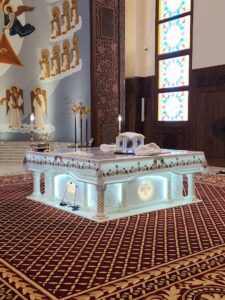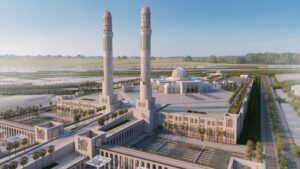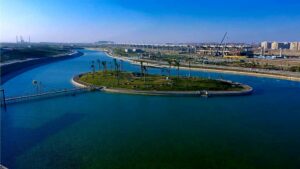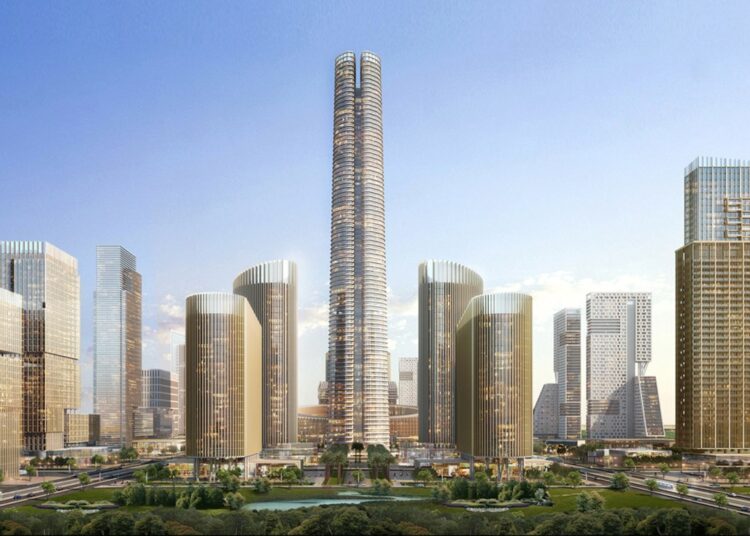Egypt’s President Abdel Fattah El Sisi gave the go-ahead for the construction of the New Administrative Capital (NAC) in 2015.
The new megacity covers 1.5 millionsquare metres. It is located around 60kilometres east of Cairo.
After completion, the new city will hopefully house 6.5 million people.
The implementation of the project is overseen by the Administrative Capital Company for Urban Development, an independent economic entity in charge of leasing space and facilities in the new city for the government and the private sectors.
The NAC has already created tens of thousands of jobs for all types of workers from all parts of Egypt during its construction.
It will also create a huge number of job opportunities for young people after its completion.
It increases Egypt’s habitual space, a crucial issue, given Egypt’s growing population.
The population is forecast to double within the coming 40 years, which calls for more housing projects to accommodate growing demand.
The relocation of government offices, including the ministries, and the parliament will also reduce pressure on Cairo and allow for the rehabilitation of the Egyptian capital, which has been suffering from overcrowding and pollution for decades now.
The NAC will house – among other things – the presidential headquarters, the headquarters of the lower and upper chambers of parliament, and the state-run ministries.
It will also house a large number of foreign embassies and consulates.
Some experts call, meanwhile, for turning the old headquarters of the ministries and government institutions in Cairo into cultural centres,libraries and hotels.
Other people suggest that these places be converted into malls and commercial markets, using their proximity to Cairo’s old markets, such as el-Mosky, Ataba and al-Azhar.
Around 14 ministries and government entities have already been relocated to the NAC, according to the Ministry of Planning last month.
Other government entities will move their offices to the new capital, in the light of directives by President Sisi, and as part of a comprehensive national modernisation strategy.
When fully operational, the NAC will be home to 50,000 government employees, according to Prime Minister MoustafaMadbouli.
He said civil servants will start working from their agencies’ headquarters in the new capital as of July this year.
“The Cabinet has fully moved its operations to the new capital,” the prime minister said during a recent meeting.
The prime minister paid several visits recently to the transport, sports and housing ministries where employees have already started working in the new headquarters.
He said he would visit other ministry headquarters in the coming days to follow up the final preparations for relocation to the new capital.
The president said in March that the government’s relocation to the NAC has to mark a real modernisation of the nation’s administrative structure.
This has to happen, the president said, through the modernisation of buildings and the training of civil servants in the latest administration techniques and digitisation methods.
President Sisi affirmed repeatedly that the NAC would demonstrate the values of modern Egypt.


Cairo is now home to over a fifth of Egypt’s population of 104 million. Hence, the NAC is the best resort to relieve pressure and overcrowdedness in the downtown.
The government hopes the new capital city will create around 2 million new jobs for young people.
The Ministry of Planning and Economic Development highlighted recently the importance of the comprehensive modernisation of the administrative apparatus by boosting governance and digitisation.
Minister of Planning and Economic Development Hala el-Saeed said the relocation of state agencies to the new capital would mark a change of thought and performance.
“It will also mark a change of management concepts, all with the aim of providing citizens with services in an efficient manner,” the minister said.
The NAC is divided administratively into 20 neighbourhoods and areas of different purposes.

It is one of the largest urban cities in the world and one of the fourth generation cities established in Egypt at present.
The new capital’s implementation happens over three phases.
The first phase covers an area of 40,000 acres, the second 47,000 acres and the third 97,000 acres.
It includes the City of Arts and Culture, Egypt International Olympic City, Knowledge City, conference centre, Exhibition City, and residential neighbourhoods, along with medical, sports and central cities.
The new capital also includes the Green River, which will extend over 35kilometres.
Attention has been given to green spaces within the city, as the new capital contains a garden of about 8kilometres. This is considered the largest central garden in the world.
There are hopes that the new city will accommodate between 18 million and 40 million people by 2050.
The space in the city has been well and effectively utilised for its residents where attention has been given to pedestrians who have been allocated about 40 per centof roads.
About 35 per centof the new capital’s space has been allocated to finance and business, with Egypt witnessing a comprehensive development, something that is manifested in the implementation of national mega-projects in various fields.
Investments in the financial and business district are estimated at around $3 billion.
Chinese CSCEC, one of the largest international firms in the field of skyscraper towers, implements the business district.
The new capital is designed to be linked to its neighbouring cities, through a large network of transportation, and a giant international airport built on an area of 33 square kilometres.

It is inspired by international capitals and designed as per the European style and high-end residential areas in the centre of Egypt, such as Qasr al-Nil, Heliopolis, and Garden City.
Thus, it is a mixture of modern innovative designs and the ancient history of the country.
An overall plan has been drawn up to allocate a large technological area in the NAC that includes many IT and software factories, which works to enhance and support the Egyptian economy.






Discussion about this post